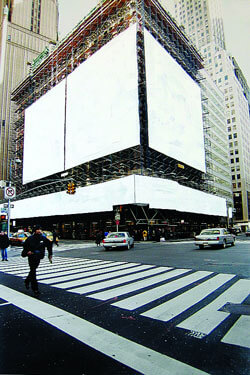Vinet’s textual whitewash; Baron’s keepsake containers
Paul Vinet, a French artist based in Washington D.C., first exhibited “Learning From New York” at Jan van der Donk Rare Books in Chelsea in 2001. The color photographs depict the city from a pedestrian’s point of view, with a slight alteration—the artist paints over signs or other text images with creamy, white paint. Vinet, with a background in photography and graphics, has an interest in how visual culture intersects with the public sphere.
In Europe, the photographs have received enthusiastic reviews. In the January 2001 edition of France Amérique, Fabienne Boulineau raved, “Forget the city as you know it, and transport yourself into a world without billboards, void of all types of advertising, commercial pollution or visual aggression—a world where the eye feels free… Maddeningly, deliriously: it’s an excruciating pleasure to behold.”
With only five pieces on view at Senior and Shopmaker, Vinet’s presentation in an intimate, gray alcove of the gallery is just right and just enough. Three selections from “Learning From New York” depict a straight-on view of the Metropolitan Museum of Art; a street scene on a block with a rare absence of retail stores; and a scaffold-encased building enshrouded in a construction scrim. The white-painted areas lead the eye to strong visual lines, be they Corinthian columns, crosswalk stripes, or standard forms of industrial architecture. The white paint handling is formed by straightforward, yet leisurely brushstrokes.
Two new works from 2004 feature crowd scenes where the background is entirely white, including a John Kerry rally, simply entitled “People,” without further ado. The white paint here has an amorphous liquidity, as if the artist had dripped paint onto the image at close range.
All of the works are mounted on aluminium and measure around 4 x 3 feet.
The title “Learning From New York” borrows cleverly from “Learning from Las Vegas,” written in 1972 by architects Robert Venturi, Denise Scott Brown and Steven Izenour. This entertaining study of the architecture, neon signs and urban design of the famed casino capital is surely the first scholarly analysis of the Sunset Strip as urban sprawl. The book offers a graphically rich collaboration between its contributors, their Yale architecture students, feisty local media and business owners and several pop artists, most notably Edward Ruscha.
One quote from that book cues into Vinet’s project: “The zone of the highway is a shared order. The zone off the highway is an individual order. The elements of the highway are civic. The buildings and signs are private. In combination they embrace continuity and discontinuity, going and stopping, clarity and ambiguity, cooperation and competition, the community and rugged individualism.”
Vinet’s notion of interrupting the photographic syntax of each color image with white paint is a quite simple idea, but nonetheless striking. Its conceptual bent and homage to “Learning From Las Vegas” link it to Ruscha’s work, recently seen in depth at the Whitney. Whereas Ruscha’s exploration of billboard signs and advertising text for its own sake eliminates the urban context, Vinet erases the sign and leaves the view on the street intact in “Learning From New York.”
Another comparison exists between Vinet and fellow French artist Daniel Buren, a theorist and acclaimed practitioner, whose work since the 1970s has questioned the contextual sphere of public art installations.
Vinet’s conceit succeeds in fulfilling the proposition that a photograph can be less a statement of the obvious than the obvious put to questioning. There are constraints on what can appear in the public sphere, but the public does not have a say about the resulting ensemble. Much to his credit, Vinet doesn’t impose moral judgments, but rather interpolates, making an insertion (the white paint) into an existing order (the photograph). It’s superficial, yet profound.
The main gallery at Senior and Shopmaker displays exquisite collages and box constructions made by Hannelore Baron, a teenage refugee from Nazi Germany to New York, who died in 1987. Her work’s tatterdemalion evocation has been compared to Paul Klee’s surrealist ethos. Stuttering lines of ink and frayed textile scraps allude to the speech of someone susceptible to life’s vicissitudes yet transcendent at the same time. Baron’s subtle engagement with ancient cultures is a reflection of her sensitivity to social issues. The sense of secrecy about language in Baron’s work provides a rich counterpoint to Vinet’s work.
MCC’s Rev. Pat Bumgardner marries four couples in protest of Bloomberg legal appeal
gaycitynews.com



































